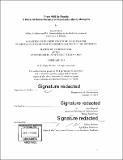There will be floods : a material remembrance of Presidents Island, Memphis
Author(s)
Fechtel, John(John Christopher)
Download1102595181-MIT.pdf (46.74Mb)
Other Contributors
Massachusetts Institute of Technology. Department of Architecture.
Advisor
Ana Miljacki.
Terms of use
Metadata
Show full item recordAbstract
In the wash of the Mississippi River just south of Memphis, Tennessee, lies President's Island, the largest island in the Mississippi. It is now no longer an island, as it was annexed in 1947 by a growing Memphis in search of land for aggressive industrial expansion. It was connected by a dredged land bridge that rendered a bizarre polygonal piece of the island immune to the regular flooding that haunts the River. Within a few years, the last permanent resident of the island had left, leaving behind a rich history literally buried in the soil. This island, known now only as an industrial park and sometime hunting ground, was at times a place of refuge for formerly enslaved people during the Civil War; a penal farm administered by the first leader of the KKK; a vice-filled island full of gamblers, cockfighters, and moonshiners; a constellation of sharecropping plots; a famous picnicking ground for Memphis residents; a dangerous shoreline pockmarked by wrecked steamboats; and the home to a quarantine station for those fleeing the devastating 1878 yellow fever epidemic. This history is now no longer present on the island, consigned only to fragmented archives throughout Memphis and the United States. This project seeks to reify the archive of this island's history into its shifting soil, to build a new agricultural cooperative on the island that operates as a kind of living memorial to those who came before, and to begin a process of reparations through land reclamation on the part of the descendants of those families who once labored there. A loose collection, or 'family', of spaces for work and production are arrayed across the site, marking it with some combination of formal intention and ecological determinism. These spaces produce goods -- food, timber, water, land, and knowledge -- to be shared between them in common. The day-by-day, season-by-season, and flood-by-flood cycles of agrarian life structure this semi-nomadic community as it moves and shifts across the landscape, building and unbuilding itself, and suggests a way to occupy ecologically and historically contested landscapes with a kind of permanent impermanence.
Description
Thesis: M. Arch., Massachusetts Institute of Technology, Department of Architecture, 2019 Cataloged from PDF version of thesis. Includes bibliographical references.
Date issued
2019Department
Massachusetts Institute of Technology. Department of ArchitecturePublisher
Massachusetts Institute of Technology
Keywords
Architecture.